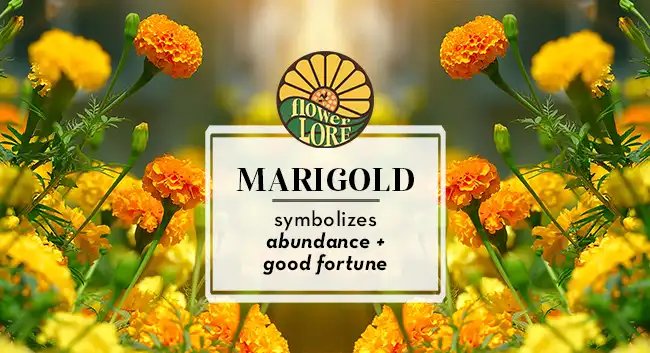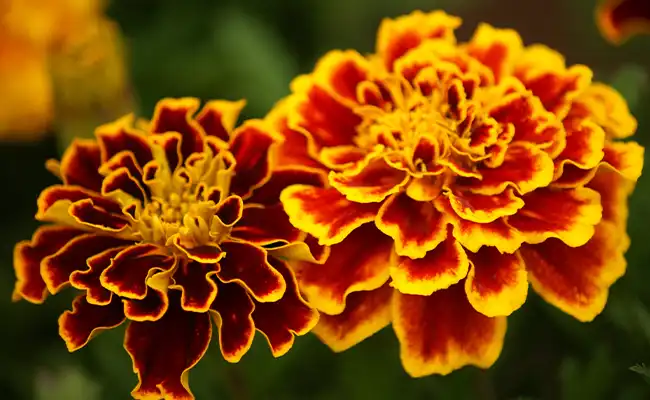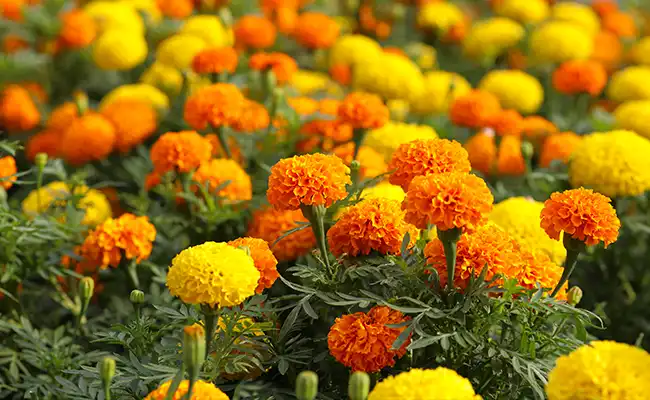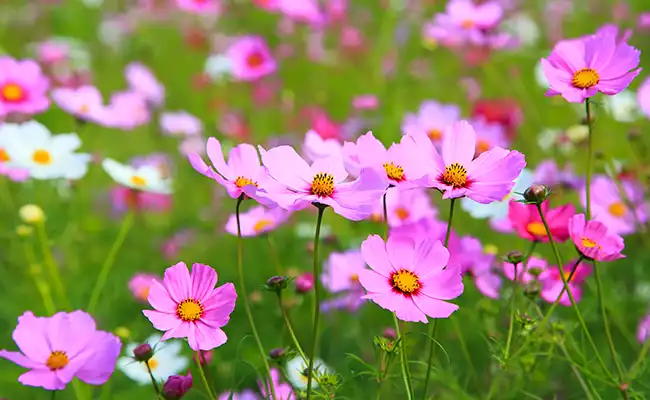Marigold The October Birth Flower

October is a golden month indeed, with the brilliantly golden fall leaves on hickories, aspens, and black maples, along with fields full of the golden shades of ripe hay, piles of orange-gold pumpkins, and so much more. It is perfectly appropriate, then, that the marigold—which is best known for its rich orange-gold coloration—is the traditional October birth flower. But the luxurious lore, meaning, and history of these flowers goes far beyond a single month, and the more you know about marigolds the better you will understand and appreciate their significance throughout the year. Jump to marigold flower meaning
RELATED: October Symbols and Signs
About Marigold Flowers
Marigolds are a classic autumn bloom in rich fall hues from a sunny yellow to various shades of orange and even a deep, rusty red-orange and other autumnal reds. There are dozens of species with different overall heights, bloom sizes, smooth or ruffled petals, and other traits, but two stand out as the most common choices for the October birth flower:
1) Tagetes erecta is also known as the American marigold, Mexican marigold, Aztec marigold, or African marigold, and is native to the southwestern United States, through Mexico, and into South America. Despite being called the “African” marigold, these flowers were introduced to Africa through trade routes, but originated in the Americas.

2) Calendula officinalis is known as the common marigold, pot marigold, Scotch marigold, herb of the sun, or Mary’s gold and is a closely related bloom, though not considered a “true” marigold. Nevertheless, this flower—which originated in southern Europe but has become naturalized in a much wider area—is also used as the birth flower for October.
Both flowers are members of the Asteraceae family, close relatives of coneflowers, dahlias, dandelions, sunflowers, chrysanthemums, and zinnias. They are herbaceous perennials and will regrow for years, reseeding themselves and thriving if conditions are right. In northern areas, these flowers are often treated as annuals, but in proper growing conditions for their southern origins, they can last for several years.
Marigolds have a distinctive fragrance, a complex aroma that may be described as spicy or musky. The scent can be quite pungent from a bouquet or large arrangement, and its overall aroma can easily be reminiscent of delicious autumn spices so fragrant during October.
Because of the strength of the aroma, however, it may also trigger allergic reactions in those with seasonal sensitivities, so it is important to be mindful about planting or giving marigolds to those with October birthdays just in case.
Related Product: October Birthstone – Rose Quartz Necklace
Marigold Symbolism
Marigolds have many different associations and meanings, depending on the flower’s color and shape. In general, these flowers symbolize caring, joy, passion, warmth, devotion, abundance, and good fortune.
Because marigolds thrive from mid-summer through autumn, easily weathering late summer storms and autumn rains, they also represent devotion, perseverance, and strength. When the flowers have ruffled or frilly petals, they are also said to denote creativity and innovation.

Marigold Flower Meaning From Around The World
As widespread blooms in different parts of the world, marigold flower meaning is a part of many different spiritual traditions and cultures around the world.
In particular, the ancient Aztecs honored marigolds and considered them sacred, with the ability to connect one to one’s ancestors with their heady aroma as well as their brilliant color which was said to light the way to and from the underworld. These beliefs have been ingrained in Mexican cultures for centuries, and even today marigolds are a key decoration for Dia de los Meurtos (Day of the Dead) in adorning altars, shrines, cemeteries, and graves of ancestors and family members as a sign of remembrance and respect. While Day of the Dead is typically celebrated from November 1-2, preparations for the event begin much earlier in October just as these birth month flowers are at their peak.
Marigolds are also honored in other religious traditions. In Buddhism, these flowers are placed on altars with lotus blossoms in honor of Buddha, while in Hinduism, marigolds are associated with the ultimate romantic couple, Lakshmi and Vishnu. The flowers are often used in weddings and marriage celebrations to bring positive energy, love, and brightness to the happy couple.
In Christian traditions, marigolds are known as Mary’s gold and were often presented before the Virgin Mary as a prayer offering when gold coins or other tributes were not available.
These flowers even appear in ancient Greek and Roman legends as springing from the tears of Helios as he mourned for the loss of his son. Alternatively, marigolds may have been created from the tears of Aphrodite as she mourned for Adonis, and these bright flowers are often associated with other legends having to do with Sun gods or Sun ceremonies.
Any questions? Contact [email protected]
Marigold Folk Medicine
It is in more than worship and legends that marigolds have been useful in different cultures over the centuries. These flowers have had medical applications in a wide range of cultures, including Greek, Roman, Egyptian, Persian, Indian, and European histories.
With anti-inflammatory and antiseptic properties, marigolds have been used as washes and poultices for wounds, as well as treating sores and skin conditions. They have also been used to treat a range of disorders such as menstrual cramps, hemorrhoids, inflamed eyes, and digestive issues. Even modern studies have shown marigolds to have some anti-viral and anti-fungal properties.
Homeopathic medicine also has various uses for marigolds through the flower’s strong fragrance. Through incense, perfumes, lotions, and essential oils, marigolds are used in different aromatherapy practices.
Practical Uses For Marigolds
Beyond medical treatments, marigolds have many other practical uses. The Calendula type of marigolds are edible, with a light citrus-like flavor that pairs well with salads and desserts. Oils infused with marigolds can be delicious dressings, dips, or marinades, and these flowers may be steeped in teas as well or even used for natural food coloring, such as imparting a stunning bright yellow to rice.
Marigolds are rich in antioxidants, and add a burst of beautiful fall color to a variety of different dishes. It should be noted, however, that the Tagetes varieties of marigolds are not as palatable and should be kept out of the kitchen.
All marigolds can help create lovely dyes for clothing, and the aroma of the flowers is often used in skin products, perfumes, lotions, cosmetics, candles, and more.
Marigold Flowers In Art And Literature
It should be no surprise that because these flowers are so widespread, revered, and useful, they have appeared over and over in different culture references, including movies, television shows, and music. Marigolds are mentioned in the works of William Shakespeare, including The Winter’s Tale and All’s Well That Ends Well, as well as various works of poetry and songs from many different artists.
Noted Mexican painter Frida Kahlo featured marigolds in many of her works, and these blooms are found on Aztec pottery as well as in modern tilework.
More unusual appearances of marigolds include a city in central California and a gold mine in Nevada. In the late 1800s and early 1900s, Marigold was a popular woman’s given name for several actresses and artists, as well as one of Winston Churchill’s daughters.
Several naval ships have had the name Marigold as well, most notably a US Army hospital ship in service from 1944-1946 during World War II—interesting considering the flower’s medicinal applications. The ship served in both the Mediterranean as well as the Pacific, and was present in the fleet when the Japanese signed their official surrender on September 2, 1945.
Marigolds have even become part of cultures for all ages, and are a fun lyric in the song “Inchworm” by Danny Kaye in 1952, a counting song with a gentle cadence and rhyme scheme to help children learn arithmetic. “Measuring the marigolds” is part of the song’s lyrics in several verses.
Growing Marigolds
Because of their popularity in so many ways, these flowers are a favorite in the garden and landscape as well. They are easy and versatile to grow, whether in flowerbeds, as borders, or in seasonal containers as porch pots or window boxes. Because marigolds may deter rabbits as well as several types of insects, including mosquitoes, they are particularly popular around patios, decks, and vegetable gardens to help provide natural protection from unwanted guests.
Marigolds prefer full sun locations to reach their most brilliant growth, and well-draining soil is a must. These fast-growing flowers can be grown from seed or seedlings, but should not be planted until after the first frost to protect their delicate roots.
Mulch can help protect the plants and conserve water at the base, as marigolds prefer a consistently moist, though not soggy soil. Fertilizing once or twice a season with an all-purpose fertilizer can help nourish these flowers, and once they start blooming in mid-summer, deadheading will ensure abundant blooms through the first frost.
For an extra autumnal touch perfect to showcase these October birth flowers, plant marigolds directly in a hollowed-out pumpkin for an instant seasonal vase, or even dry the blooms upside down earlier in the season to be able to add them to autumn centerpieces.
Cosmos — The Alternate October Birth Month Flower
Just as most months showcase two different symbolic flowers, marigolds are not the only birth month flower associated with October. Cosmos (Cosmos bipinnatus) is widely considered another option, and adds even more beauty to the month. From the Greek “kosmos” these flowers have a unique astronomical connection, giving them out-of-this-world character.
Cosmos symbolize courage, passion, renewal, serenity, innocence, peace, calm, joy, and modesty, and their colors range from pink and red to white, orange, yellow, and different purple shades. The balanced petals of cosmos are aesthetically pleasing, and these flowers are easily grown from seed in similar conditions to marigolds.
Also members of the Asteraceae family, cosmos are closely related to marigolds, and mixed bouquets of both blooms can be especially meaningful for any October occasion, from birthdays and anniversaries to a wide range of celebrations and special events.

Join The Discussion
Which October birth month flower do you prefer: marigold, cosmos, or a different flower?
Did anything surprise you about the marigold flower meaning?
Share your thoughts, tips, and tricks in the comments below!

Melissa Mayntz
Melissa Mayntz is a writer who specializes in birds and birding, though her work spans a wide range—from folklore to healthy living. Her first book, Migration: Exploring the Remarkable Journeys of Birds was published in 2020. Mayntz also writes for National Wildlife Magazine and The Spruce. Find her at MelissaMayntz.com.





